 Hedera colchica
Hedera colchicaCopyright 2003. New Ornamentals
Society. All Rights Reserved.
Lawful for online access only by current society members.
All downloading, printing, saving to media, imaging, screen capture, or offline
use is prohibited.
Duplication by any means, method, or technology is unlawful.
Do not link to this page.
The correct literature citation for this document is:
Hatch, Laurence C. [current year]. IVYfile. New Ornamentals
Society. Raleigh, North Carolina.
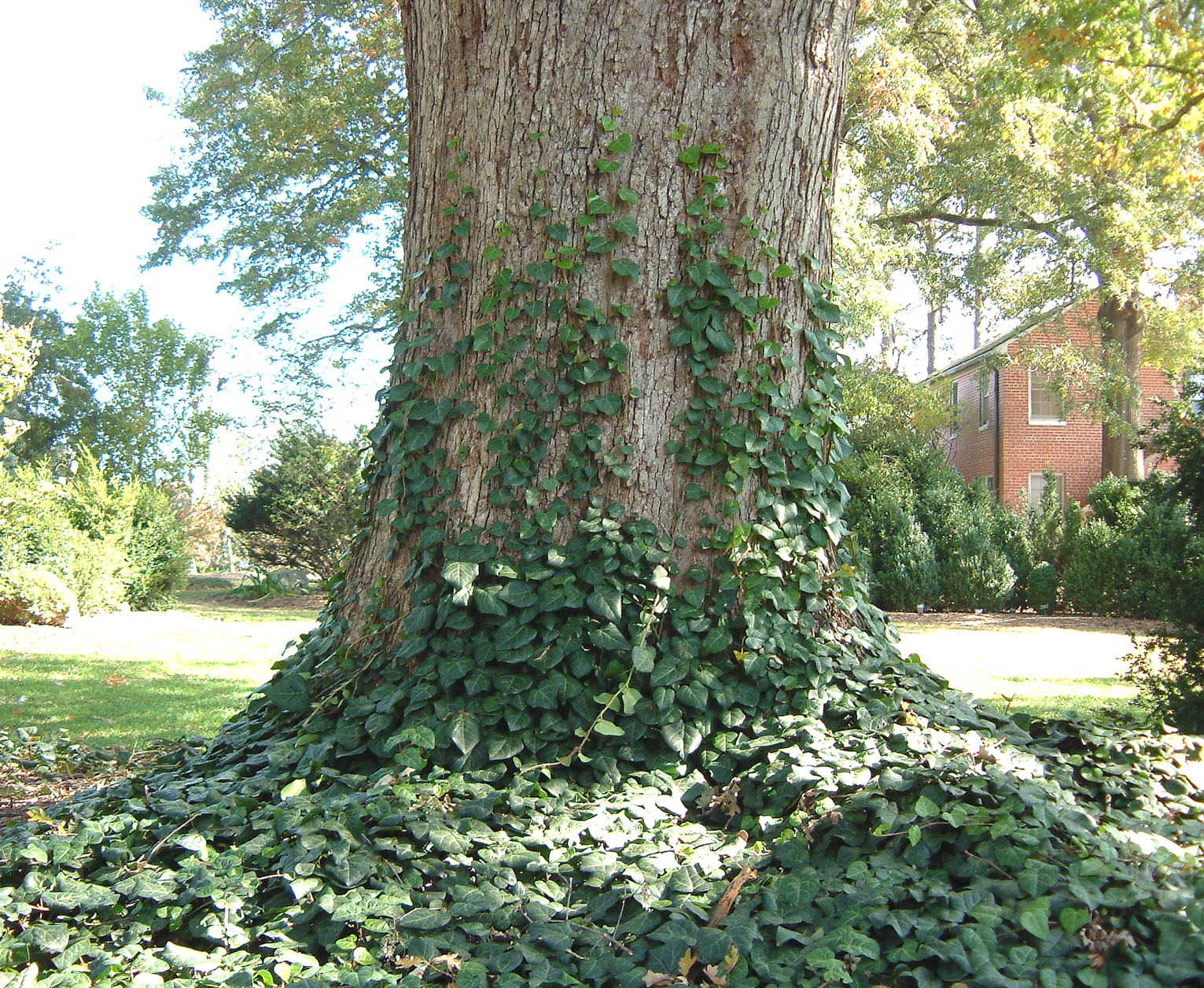 Hedera colchica
- click on image
Hedera colchica
- click on image
JC Raulston Arboretum. This lovely
pairing of H. colchica and Quercus alba attracted many visitors
and more than a few cameras. Until the liability police arrived people used to
wing from a wooden seat under the towering limbs. Students loved to study under
the shade and couples whispered sweet things from the swing. The ivy added a
rich verdant color and lovely light reflections. Without the ivy the scene was
not complete. Unfortunately images are all we have left of this scene. Crown rot
and a freak ice storm conspired to produce this horrific and startling scene....
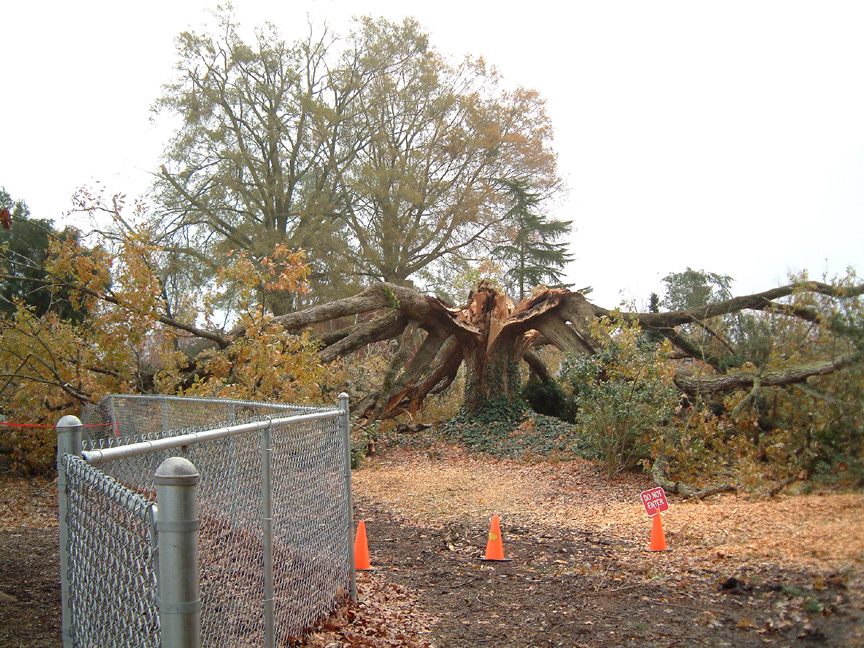 click
image. This is a tree that lived over 200 years including Hurricane Fran at 88
miles per hour in this very region. Did the ivy contribute to the tree's rot?
Nearly impossible. Oaks live for centuries with ivy cloaks and remain as strong
as ever. Wood decay is quite common in Quercus alba in hot humid climates
and ivy or not many of them fall about this age.
click
image. This is a tree that lived over 200 years including Hurricane Fran at 88
miles per hour in this very region. Did the ivy contribute to the tree's rot?
Nearly impossible. Oaks live for centuries with ivy cloaks and remain as strong
as ever. Wood decay is quite common in Quercus alba in hot humid climates
and ivy or not many of them fall about this age.
Hedera colchica
'Arborescens' = 'Dendroides'
Hedera colchica
'Batumi'
ls, ll: 9-13cm long - intermediate in size and shape
between garden species and 'Dentata'. Very shallowly lobed or entire.
lc: glossy rich green
or: Roy Lancaster found in Batumi, Russia 1979 near the Black Sea
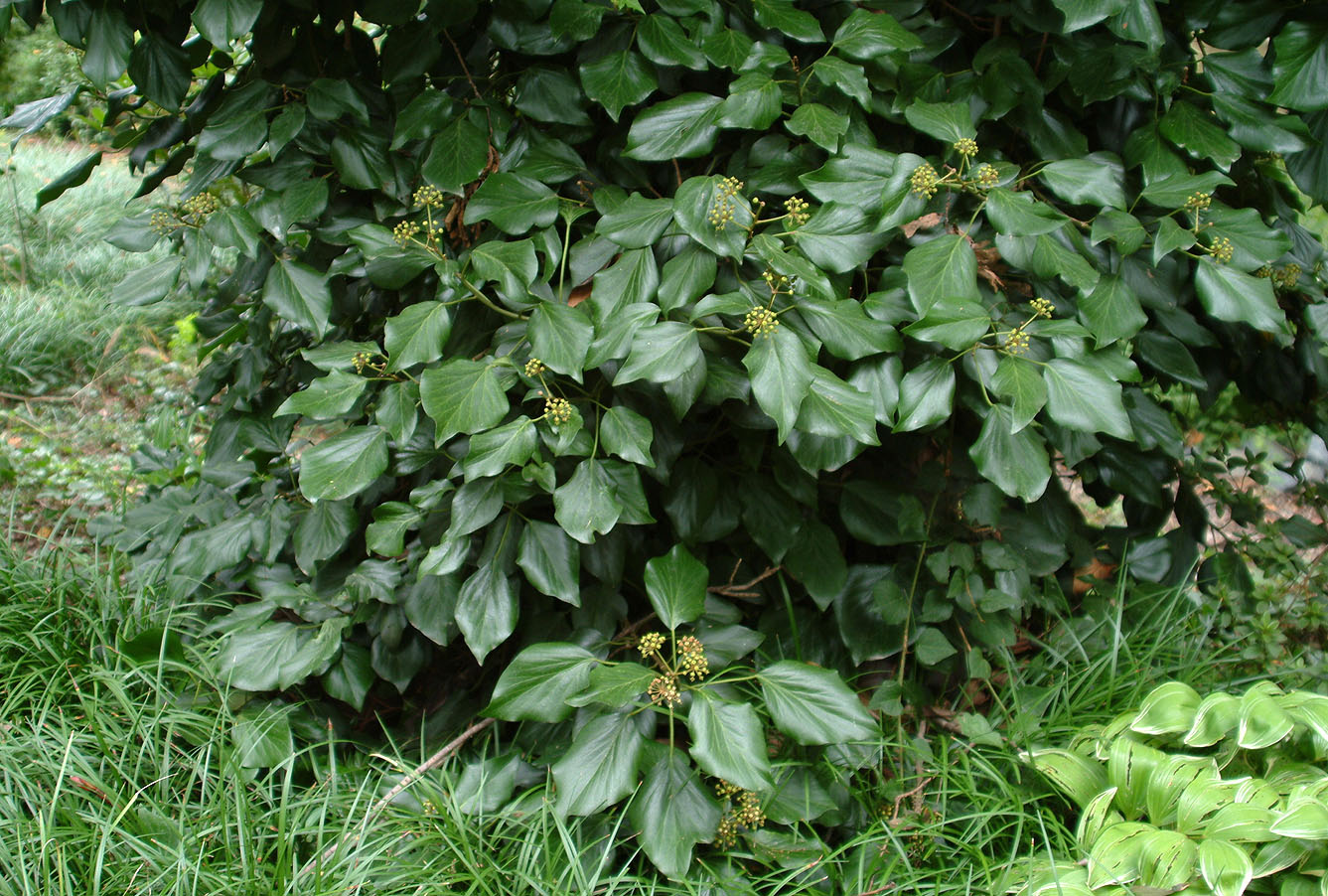 climbing
adult phase - click on image
climbing
adult phase - click on image
Gardens, University of North Carolina
- Charlotte. September 2003. A particularly pretty flowering phase that climbs
with very large
blades. It is probably just "semi-adult" as it sprawls at the base and is very
vigorous. Still it does flower and that's a sign of maturity.
It does not fit the exact leaf shape of 'Dendroides' which is virtually unknown
in the US. These leaves are however a full 4-6 inches
long and not the 2-3 of 'Dendroides'.
Hedera colchica [climbing adult
phase]
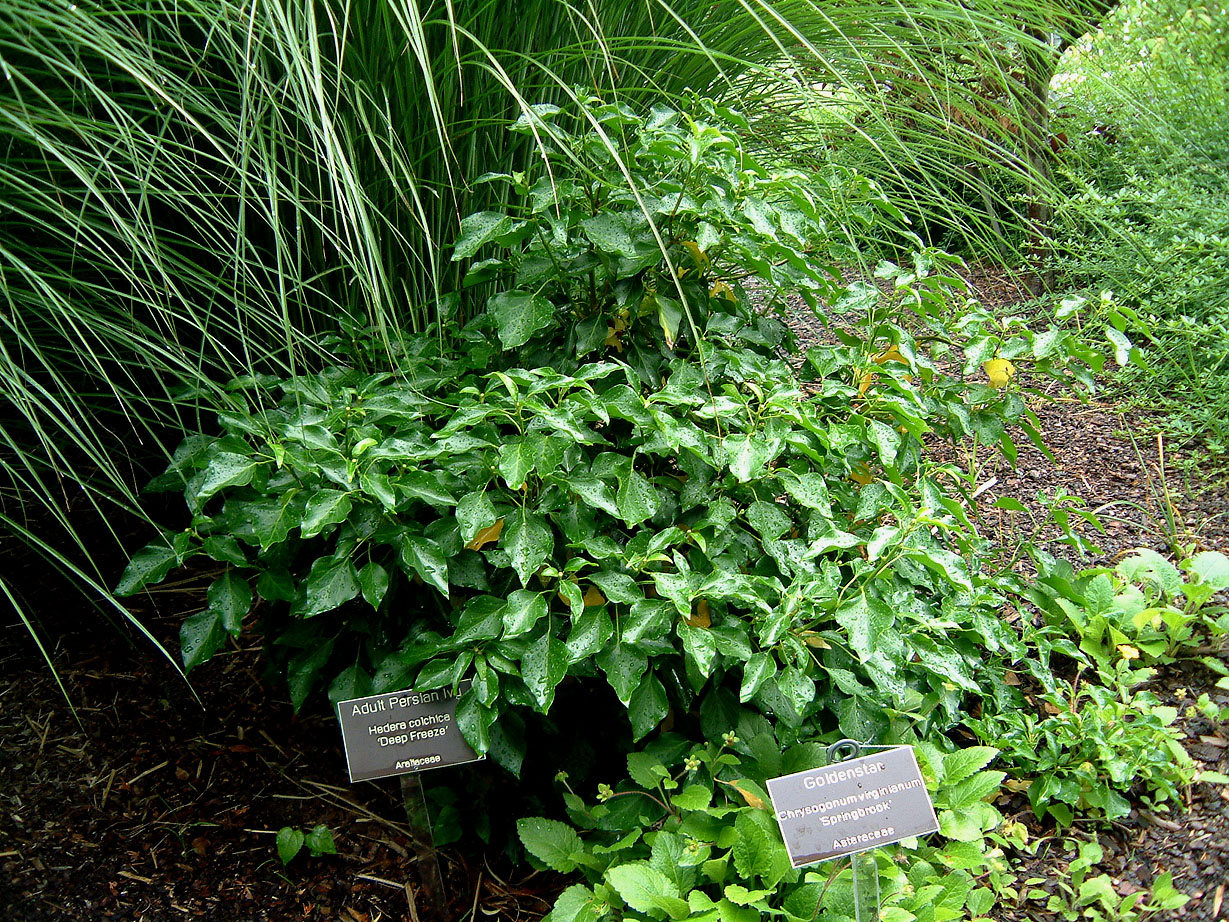 'Deep
Freeze' - click on image
'Deep
Freeze' - click on image
Lewis Ginter Botanical Garden. Summer
2003. This is one of the newer shrub clones in a more cold hardy clone.
Hedera colchica 'Deep
Freeze'
Hedera colchica 'Dendroides'
('Arborescens')
ha: vining, not completel arborescent in the common
clone
st: purple tinged
ll: 5-10cm long.
ls: ovate, unlobed, margins often curved under.
lc: glossy dark green - Rose states that another clone is paler and matt
finished.
Hedera colchica 'Dentata'
ha: more vigorous than species typical of gardens,
hence more popular in the trade and cheaper to produce.
ll:15-25cm - larger than species typical at just 6-15cm.
lm: irregularly spaced teeth - species is mostly entire (toothless) or with only
the occasional tooth. Margins curl downward
lm: on the larger, older blades and may hide the teeth.
or: Franz J. Ruprecht, German botanist found in Caucasus
in: Haage & Schmidt Nursery, Germany c. 1868
Hedera colchica
'Dentata Aurea' = 'Dentata Variegata'
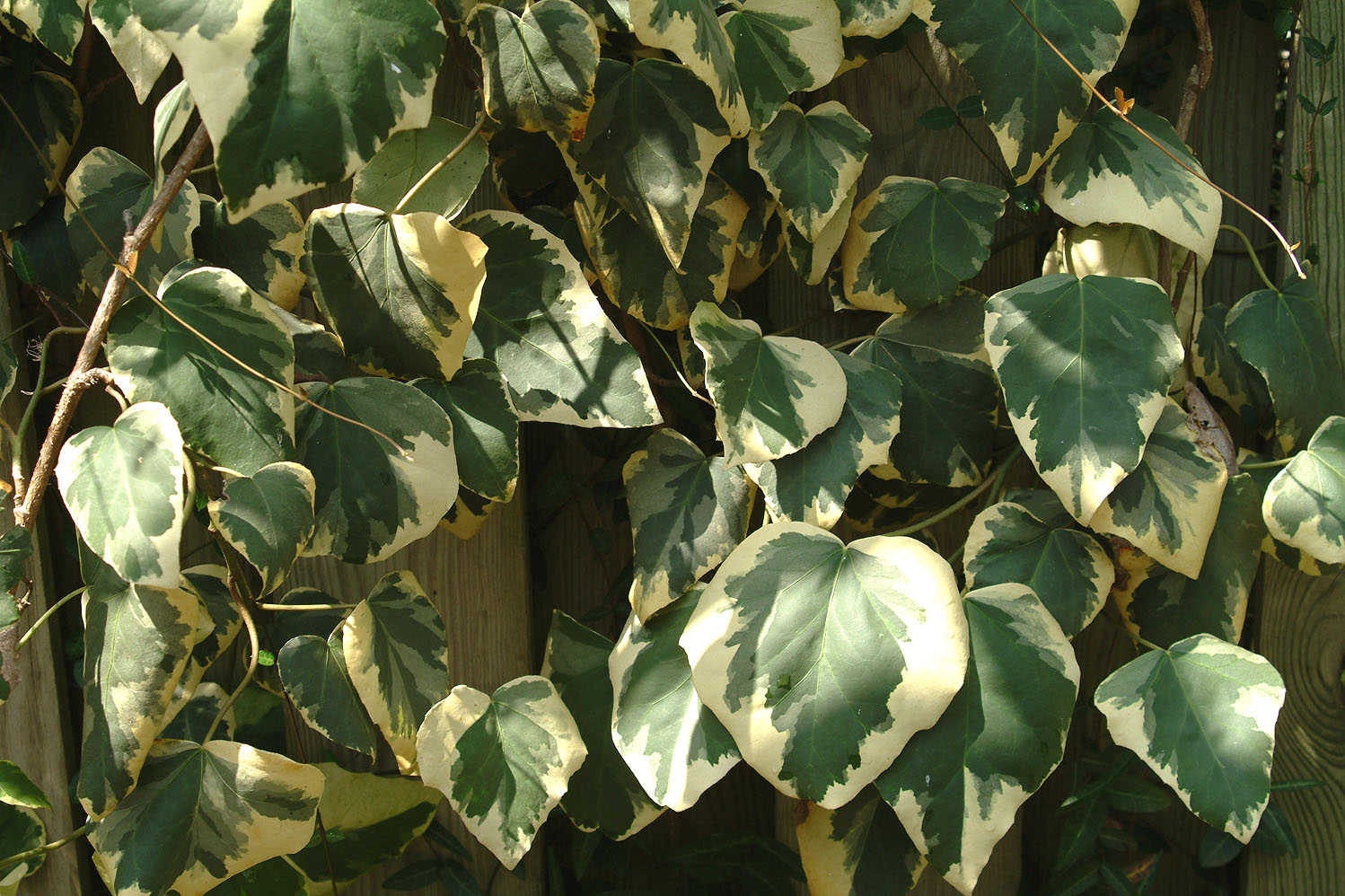 'Dentata
Variegata' - click on image
'Dentata
Variegata' - click on image
JC Raulston Arboretum. September 2003.
This lovely variegate differs from H. canariensis 'Gloire de Marengo' in 1) new
margins more yellowish to cream,
2) lack of rich reddish-purple stems and petioles (only faint red or brown tints
if any), 3) distinct marginal teeth or sharply pointed lobes.
Hedera colchica
'Dentata Variegata' ('Dentata Aurea')
ha: vigorous vine
lc: irregularly margined yellowish-cream, yellower at
first, chimera being 25-40% of blade. The plant is less bright yellow in warm
summer climates in my experience but
lc: I would not rule out the plant imaged above being another clone (see Peter
Rose's bright gold-margined photo in his 1996 book - that noted his 'Gloire de
Marengo'
lc: seems too yellow as well). Small rooted cuttings under strong fertility seem
to be more yellow of any. As the plants age and grow the color is paler.
or: L.R. Russell Nursery, Richmond, England before 1907. Found in a garden near
Mr. Russell's nursery and clearly a sport of 'Dentata' type. Rose
or: mentions that the owner of the garden corresponded with them to ask for some
of the proceeds. No reply or payment records are known. We
or: know what would have happened today with such a dispute!
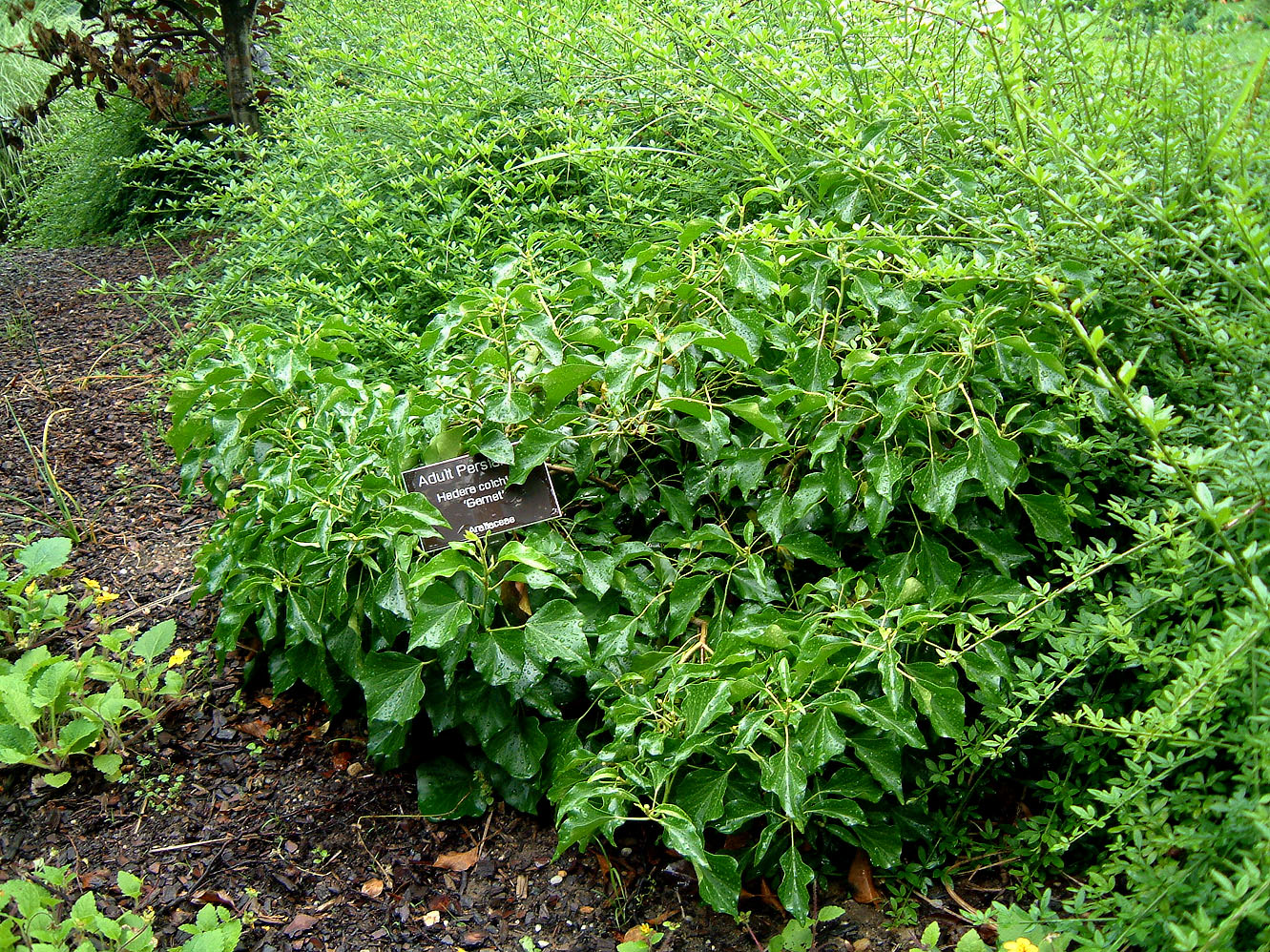 'Garnet'
- click on image
'Garnet'
- click on image
Lewis Ginter Botanical Garden. Summer 2003. One of the new improved shrub
clones.
Hedera colchica 'Garnet'
Hedera colchica
'Green Spice'
ht: 36-48 in.
ha: adult, arborescent, non-vining
lc: dark blackish-green
ls: margins down-turned, apparently differing in this respect from 'Garnet' and
'Deep Freeze' above
fc: greenish-white, showy
or: Richard Davis, Ivy Farm before 2002
so: Plant Delights
(Fall 2003 Catalog: 15, with color photo)
Hedera colchica 'My Heart' = typical
species?
ns: this nomenclatural conclusion arises from Rose's
ivy book and his dismissal of Pierot's 1974 conclusion of it being
ns: specific, perhaps more regularly cordiform clone. Pierot did have some
mistakes (very few) but I am far more disturbed
ns: at the British hederologists lumping things they have never seen and do not
understand. Have they obtained this
ns: stock from Pierot's sources or other US growers? If so, the evidence is
lacking.
Hedera colchica 'Paddy's Pride' = 'Sulphur
Heart'
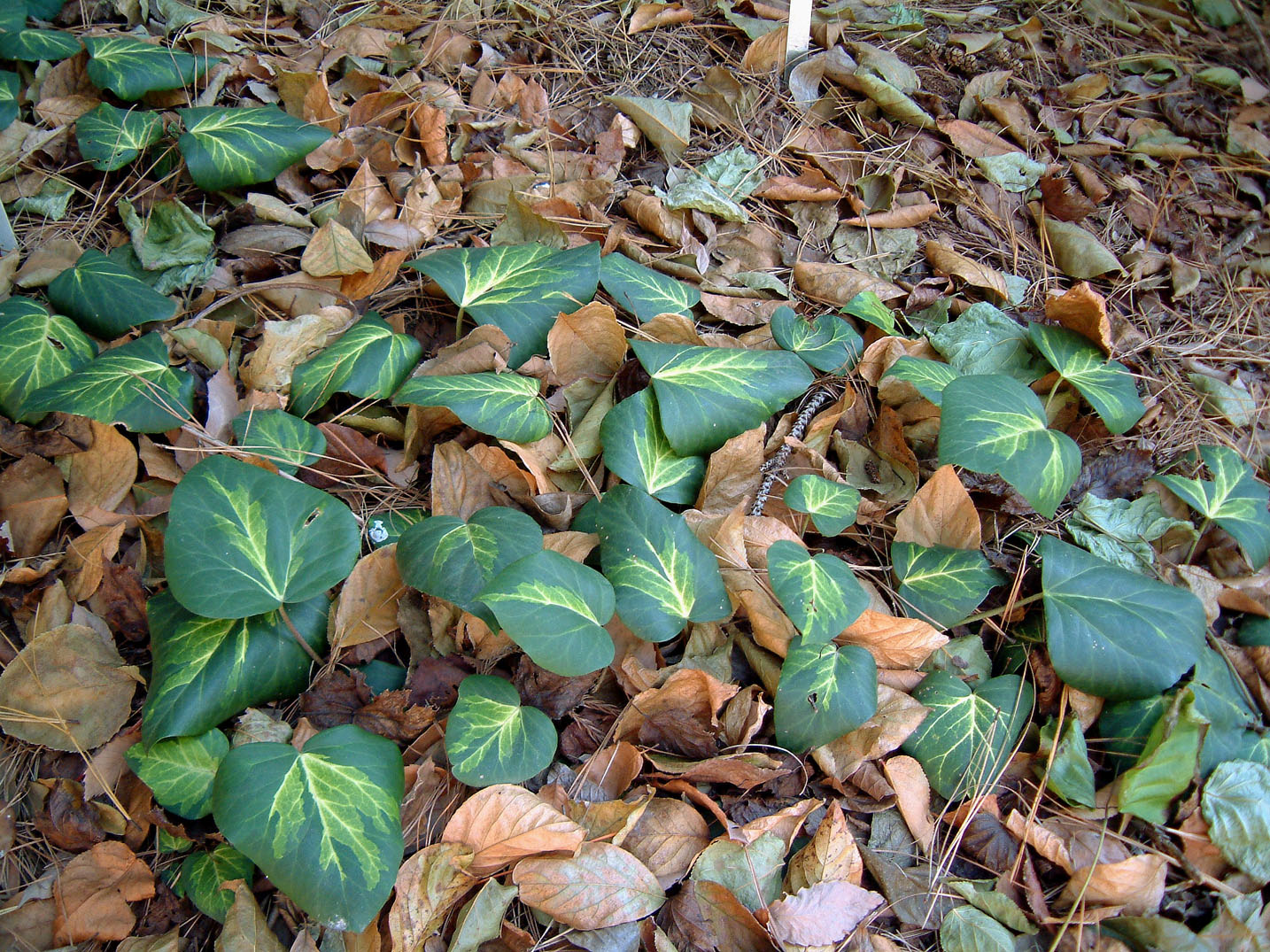 'Sulphur
Heart' - click on image
'Sulphur
Heart' - click on image
JC Raulston Arboretum. Fall 2002. A
nice patch of it rambling through fallen leaves behind the Japanese Garden. This
is one ivy that is truly living art.
Hedera colchica 'Sulphur Heart'
('Paddy's Pride', 'Dentata Aureo-striata', 'Gold Leaf')
lc: centered yellow to varying degrees on a single
plant, some very large solid gold centers of 60% of surface while others are
greenish-yellow swirls in the middle, and
lc: still others are ornately etched and nothing more than a few yellow veins.
The chimera is fairly unstable and gives one endless combinations of thickness
and
lc: those shades from gold to green. Good selection is needed to keep the clone
strong. I have seen nurseries selling nothing but the most thinnly veined stuff
lc: it is unclear if such plants could ever recover with full color again. The
veins in the middle of the chimera are almost always yellower than the
surrounding
lc: and spreading cell layers.This suggests the chimera can only be very thin
between the secondary and tertiary veins.
ls: margins often curved under, more so than 'Dentata', some being almost rolled
in half during cold weather.
ll: 8-14cm long - very large
or: known in England before WWII under the unpublished dentata aureo-striata.
Nannenga-Bremekamp published the current name in 1970. Roy Lancaster
or: about the same time in 1970 published 'Paddy's Pride' for a plant in
Ampfield, Hampshire.
Hedera colchica 'Variegata' =
'Dentata Variegata'
 Hedera colchica
- click on image
Hedera colchica
- click on image click
image. This is a tree that lived over 200 years including Hurricane Fran at 88
miles per hour in this very region. Did the ivy contribute to the tree's rot?
Nearly impossible. Oaks live for centuries with ivy cloaks and remain as strong
as ever. Wood decay is quite common in Quercus alba in hot humid climates
and ivy or not many of them fall about this age.
click
image. This is a tree that lived over 200 years including Hurricane Fran at 88
miles per hour in this very region. Did the ivy contribute to the tree's rot?
Nearly impossible. Oaks live for centuries with ivy cloaks and remain as strong
as ever. Wood decay is quite common in Quercus alba in hot humid climates
and ivy or not many of them fall about this age. Hedera colchica
Hedera colchica



